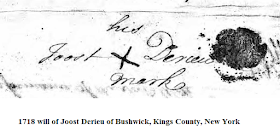 |
New York
County, New York, Wills and Probate Records, 1658-1880 (New York State Archives) for Joost
Deriew (#787) at Ancestry.com. J0038-92:
Probated Wills, 1662-1827. Wills,
0621-0820, (1662-1761).
|
Duryea is one of the most researched names in my family tree. The patriarch Joost, whose surname was spelled in different ways, removed from Mannheim (Germany) and settled in New Utrecht, Kings County, New York, around 1675. Today thousands of people can trace their descent from Joost.
Although Joost is long gone, his Y chromosome survives in his direct male descendants, passed from father to son through the generations, identical unless a mutation occurred.
My grandmother's first cousin, Bruce, supplied his Duryea Y chromosome for testing at Family Tree DNA to further research into the Duryea family history. (Bruce passed away in 2015.)
In the database four other descendants of Joost are identified.
Below is family tree demonstrating the relationships of the five tested men among themselves and to their common ancestor, Joost.
Person 3 is Bruce (my first cousin, twice removed). He was in the ninth generation, making him nearest Joost. He tested 111 markers. Person 1 tested 37 markers. Persons 2, 4, and 5 tested 67 markers.
Persons 1 and 2 descend from Joost's son Joost. Bruce and Persons 4 and 5 descend from Joost's son Charles.
The 67 markers of Persons 4 and 5 are identical. They differ from Bruce by a genetic distance of two out of 67 markers and from Person 1 by a genetic distance of 1 out of 37 markers.
The outlier is Person 2. His closest relation, Person 1, also a descendant of Joost's son Joost, more closely matches the descendants of Joost's other son, Charles.
We could say that the patriarch Joost's Y chromosome was likely the marker values seen in Persons 4 and 5.
This is my first opportunity to compare Y-DNA among testers who are related by a paper trail. Any comments or suggestions are appreciated.
Thank you to Roberta Estes for her illustrations and explanations of Y-DNA and to Jim Owston for his case study.



No comments:
Post a Comment